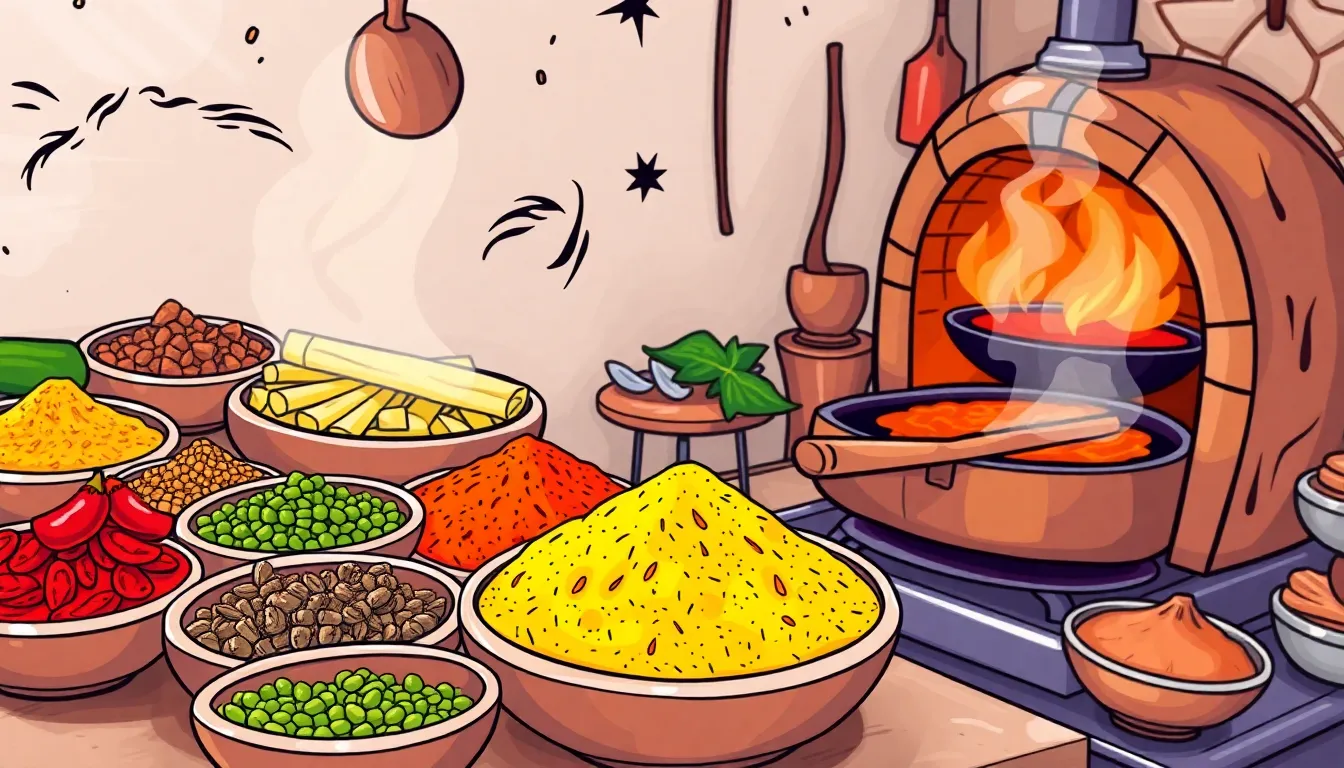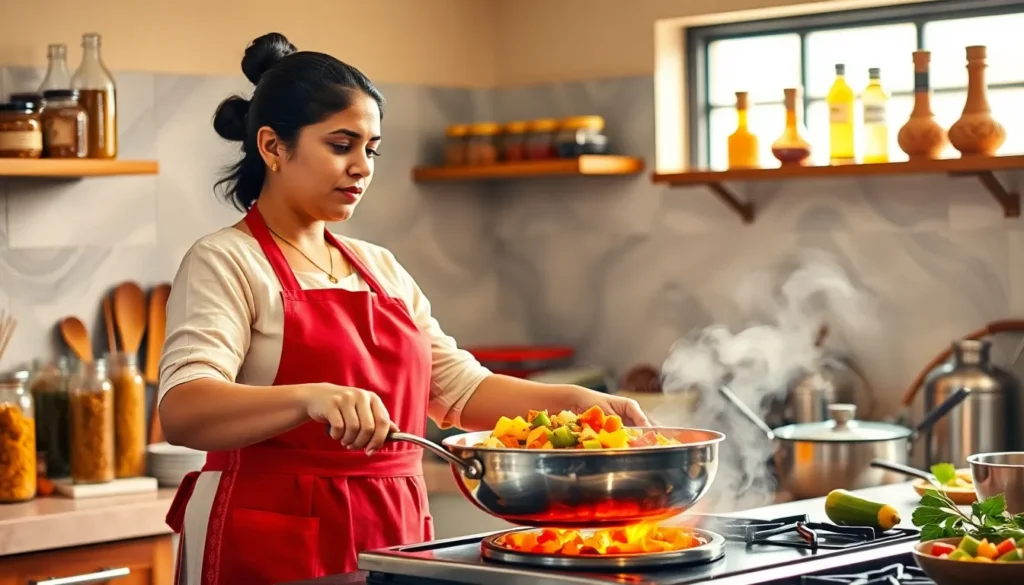Indian cooking isn’t just a way to prepare food; it’s an art form that dances on the palate and tells stories of tradition. With a symphony of spices and a dash of flair, these techniques transform simple ingredients into culinary masterpieces. Whether it’s the sizzle of a hot tawa or the slow embrace of a simmering curry, each method brings a unique flavor to the table.
Table of Contents
ToggleOverview of Indian Cooking Techniques
Indian cooking techniques involve a variety of methods that highlight the rich diversity of flavors. Techniques such as sautéing, simmering, and frying form the backbone of many Indian dishes. The use of spices during cooking enhances the aroma and taste of ingredients.
Sautéing, known as “bhunao,” requires cooking spices in hot oil to build flavor. Cooks achieve a depth of taste by carefully balancing ingredients. Simmering allows curries to develop their profiles over time, ensuring a harmonious blend of spices.
Another essential technique is steaming, commonly used for dishes like idlis and dhoklas. This method preserves nutrients while creating light and fluffy textures. Frying techniques, such as deep-frying or shallow-frying, result in crispy snacks like pakoras and samosas.
Grilling, or “tandoori cooking,” showcases marinated meats and vegetables, enhancing their natural flavors. This technique often focuses on achieving a smoky, charred taste. Slow cooking, prevalent in dishes like biryani, integrates spices deeply into the ingredients, creating rich, complex flavors.
Indian cooking also embraces the use of pressure cooking, which reduces cooking time while retaining moisture and flavor. It’s a practical method, especially for lentils and beans, ensuring they become tender quickly.
Finally, fermentation plays a critical role in producing items like dosa and yogurt. This technique not only develops unique flavors but also enhances digestibility.
Collectively, these methods reveal the artistry and tradition behind Indian cooking, showcasing its vibrant culinary heritage.
Key Cooking Techniques

Indian cooking showcases a variety of techniques that enhance flavors, textures, and nutritional value. Understanding these methods is vital for anyone interested in this rich culinary tradition.
Sautéing and Tempering
Sautéing involves cooking ingredients quickly over high heat with a small amount of oil. This method intensifies flavors, making it ideal for dishes such as stir-fries or curries. Tempering, or “tadka,” adds another layer of flavor. In this technique, spices are heated in oil until fragrant, then mixed into the dish. Lively spices like mustard seeds, cumin seeds, and dried red chilies infuse oils with their flavors. This method transforms a simple dish into a fragrant masterpiece.
Steaming
Steaming preserves vitamins and delivers a healthier cooking option. This technique involves cooking food using steam from boiling water. Many Indian dishes like idli and dhokla utilize steaming to enhance texture and maintain nutrients. This cooking method also allows for the showcase of natural flavors without excessive oils. Rice and vegetables benefit from steaming, providing a light yet satisfying meal.
Baking and Roasting
Baking and roasting play significant roles in Indian cuisine. These techniques often enhance flavor through caramelization. Naan and other breads achieve a delightful texture when baked in a tandoor, a traditional clay oven. Roasting spices also deepens their flavor profile, allowing for richer curries. In addition, roasting vegetables brings out their natural sweetness, resulting in vibrant, satisfying dishes.
Regional Variations in Cooking
Regional variations in Indian cooking techniques reflect the diverse cultural heritage across the country. Different states embrace unique ingredients and methods, showcasing a variety of culinary artistry.
Northern Indian Techniques
Northern Indian cooking often emphasizes the use of dairy, bread, and rich gravies. Techniques like slow cooking bring out deep flavors in dishes such as biryani and butter chicken. Tandoori cooking remains prominent, with marinated proteins grilled in a traditional clay oven, producing distinct smoky flavors. The use of ghee as a cooking fat enhances richness and aroma. Stewing is common for preparing hot, hearty meals served with naan or parathas.
Southern Indian Techniques
Southern Indian techniques prioritize rice and lentils, featuring methods that include steaming and fermentation. Idli and dosa preparation utilizes fermented batter, resulting in soft and crisp textures. Coconut is frequently used, both shredded and in milk form, to provide richness in dishes. Stir-frying occurs in many regional favorites like vegetable avial, which combines various vegetables and spices. Seasoning with mustard seeds and curry leaves enhances the aromatic profile of dishes.
Essential Equipment for Indian Cooking
Essential tools enhance the efficiency and flavor of Indian cooking. The tawa, a flat griddle, proves vital for making chapatis and dosas. This versatile pan retains heat well for even cooking.
A pressure cooker stands out as an indispensable piece of equipment. It cooks dishes like lentils and stews rapidly, locking in flavors and nutrients. This time-saving device suits busy kitchens.
The immersion blender simplifies blending soups and sauces directly in the pot, freeing up extra dishes. Its compact design makes it easy to store, and it quickly purées ingredients for smooth curries.
Spice grinders are crucial for achieving freshly ground spices, which profoundly enhance flavor. Whole spices release their oils and aromas when ground, elevating the dish significantly.
A set of heavy-bottomed pots excels in preventing burning and ensuring even cooking. Their sturdy construction supports slow-cooked curries, allowing flavors to meld beautifully.
Mortars and pestles serve traditionalists well, offering a method to grind herbs and spices manually. This technique provides a unique texture and aroma that machines can’t replicate.
The tandoor oven is essential for authentic naan and kebabs, creating a distinct smoky flavor. This clay oven reaches high temperatures, yielding perfectly cooked dishes with a charred finish.
Finally, a fine mesh strainer facilitates tasking, such as draining excess liquid from cooked vegetables or lentils. This simple tool ensures optimal consistency in the final dish.
These tools collectively empower cooks to create delicious Indian dishes, preserving the richness of culinary traditions.
Mastering Indian cooking techniques opens the door to a world of flavors and traditions. Each method not only enhances the taste but also tells a story of cultural heritage. From the sizzling tawa to the aromatic tadka the artistry involved in Indian cuisine is unparalleled.
Understanding these techniques allows cooks to appreciate the depth and diversity of Indian food. Whether it’s the slow-cooked gravies of the North or the steamed delights of the South every dish reflects a unique regional identity. With the right tools and techniques anyone can embark on a culinary journey that celebrates the essence of India’s rich gastronomic landscape.





